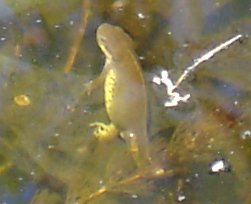|
Eastern Newt (Notophthalmus viridescens) - Wiki
| 제목: | Eastern Newt (Notophthalmus viridescens) - Wiki
| |

| 해상도: 251x204
파일크기: 10343 Bytes
등록시간: 2007:02:04 07:52:57
|
Eastern newt
From Wikipedia, the free encyclopedia
[Photo] A red spotted newt in the adult aquatic stage. Photo taken by cmouse in Massachusetts. http://en.wikipedia.org/wiki/User:Cmouse
The Eastern newt is a common newt in eastern North America. This species has four subspecies:
- Red-spotted newt (Notophthalmus viridescens viridescens) is one of the most common salamanders in the eastern United States and Canada.
- Central newt (Notophthalmus viridescens louisianensis) prefers southern climates.
- Peninsula newt (Notophthalmus viridescens piaropicola) inhabits the Florida Panhandle.
- Broken-striped newt (Notophthalmus viridescens dorsalis) is found in the Carolinas and has spots which resemble broken stripes rather than circular spots.
Eastern newts dwell in wet forests with small lakes or ponds. They may coexist in an aquatic environment with fish, because their skin secretes a poisonous substance when the newt is threatened or injured. They have a lifespan of 12 to 15 years in the wild, and may grow to 5 inches in length. The newts are a common aquarium pet, being either collected from the wild or purchased.
Life stages
Eastern newts have three stages of life: the aquatic larva or tadpole, the red eft or terrestrial juvenile stage, and the aquatic adult. The larva possesses gills and does not leave the pond environment where it was hatched. Larvae are brown-green in color, and shed their gills when they transform into the terrestrial red eft. The red eft is bright orangish-red in color, with darker red spots outlined in black. An eastern newt can have as many as 21 of these spots. The pattern of these spots differs among the subspecies. After two or three years, the eft begins to transform into the aquatic adult. The adult's skin is olive green, but retains the eft's characteristic outlined red spots. It has a larger and wider tail and characteristically slimy skin.
Habitat and diet
Eastern newts are at home in both coniferous and deciduous forests. They need a moist environment with either a temporary or permanent body of water, and thrive best in a muddy environment. During the eft stage, they may travel far from their original location. Red efts may often be seen in a forest after a rainstorm. Adults prefer a muddy aquatic habitat, but will move to land during a dry spell.
Wild eastern newts eat a variety of foods such as insects, small mollusks and crustaceans, young amphibians and frog eggs. Captive adults have been known to eat ground beef or dog food.
Captive care
A small group (1-3) of adult eastern newts can be maintained in a 10-gallon aquarium half filled with pure water and equipped with an air-operated filter. The aquarium should be topped with a screen lid to prevent the newts from escaping and to provide proper ventilation. The newts will require an area to haul out of the water from time to time; this can be provided with a piece of driftwood or terra cotta pots filled with aquarium gravel. If desired, a pothos or other semi-aquatic plant can be placed in the pot to help absorb nitrogenous waste produced by the newts. Provide hiding places for the newts in the form of aquarium plants and/or small clay pots on the bottom of the aquarium. Water temperatures in the aquarium should stay between 60°F and 70°F. 10-20% of the water in the newt aquarium should be replaced every week. Feed the newts earthworms, redworms, mosquito larva (collected from non-polluted sources), brine shrimp and dog food rolled into tiny bite-sized pieces. Net out any uneaten food to avoid fouling the water.
Trivia
The Red-spotted Newt subspecies is the State Amphibian of New Hampshire.
http://en.wikipedia.org/wiki/Eastern_Newt
| The text in this page is based on the copyrighted Wikipedia article shown in above URL. It is used under the GNU Free Documentation License. You may redistribute it, verbatim or modified, providing that you comply with the terms of the GFDL. |
|
^o^
동물그림창고 똑똑전화 누리집
^o^
|
|